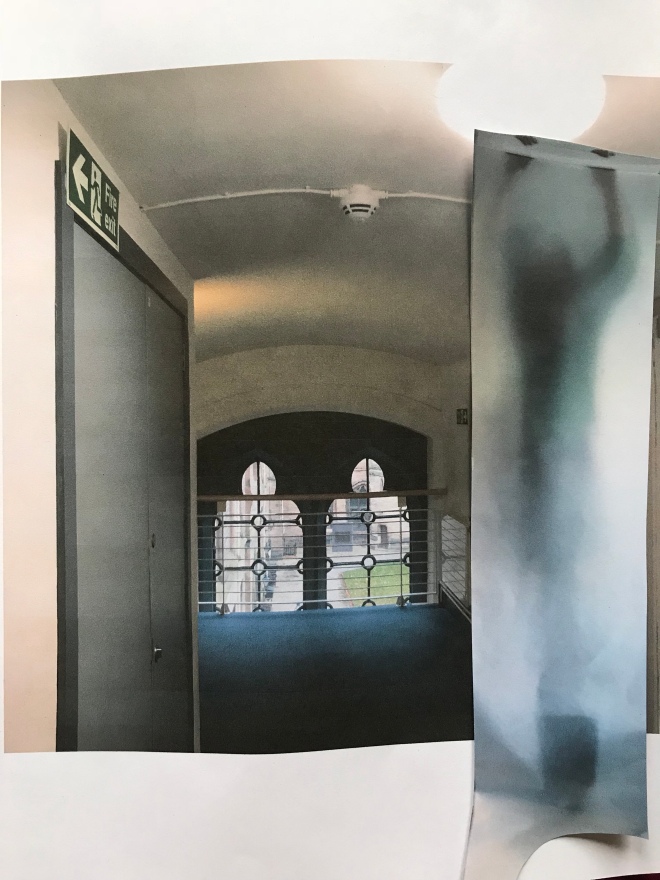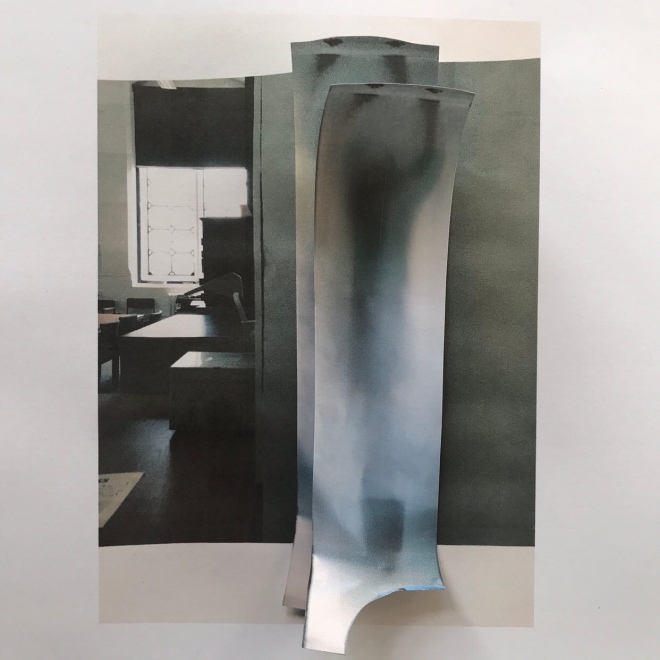This, the final, and thus first post to encounter on this blog includes two sections from the overall course document: firstly, a course reflection; secondly, a set of instructions of how to approach this work (both in analogue and physical form)
Reflection on the overall module
This module concludes with the parallel project: parallel praxis and a final editing of the critical review essay on interdisciplinarity and ambiguity in Joan Jonas’s work. These conclusions come with a tight schedule for submission and yet seem fitting, complete. Organising the material – digital and analogue – for assessment allows me to reflect and engage with the materials of the last 14 months.
The parallel project indeed relates back and looks back to the module itself, it reorganises the materials and lets them become something else still. The video is not just a narration, an instruction; I begun to include the key clips – visual, and also found sound recordings – in the work to author it and let it unfold. In this sense, it draws on a number of senses and sensations, and indeed revolves around an exploration of a body (mine) as drawing tool, investigating the reaches of what constitutes an extended field of drawing. It speaks out of the screen to ask the viewer to engage directly with some other materials. With this, it resonates with both Joan Jonas’s and Katrina Palmers’s work: they engage, performatively, and in doing so make visible and audible that engagement between artist and audience, viewer, reader, interlocutor. Will it work? Does it fail? What happens instead? In this parallel project, there is a literal voice – mine – and in its clarity it also helps to articulate all those other voices that are involved in my art-making, an art-making that is visual, textual, increasingly dares to be performative; it takes in things I learned before: critical social theory; dialectics; a body/dreamwork coaching and counselling training; a dissatisfaction with academic publishing; a keenness on finding those other spaces and places that are never entirely utopian but offer a hunch, a first step from here to there.
In this process, Drawing 2 deepens my engagement with a movement between digital and analogue (continuing from DI&C): the submission reflects this. It also continues with questions over what constitutes site, audience, work > explored in different ways and always with an exploration of this movement digital/analogue (initially: gap, agency, control (generative systems, drawing machines); then: what constitutes drawing; the kind of tools: office tools;)
One of the key challenges for presenting this work for assessment was a difficulty of presenting work across digital/analogue; notably the former: as much is worked out in FB albums; relatively late I decide to make two of these available (one as sketchbook file in the g-drive; one as a set of 4×6 photographic prints) but a moving image format isn’t easily transferred, and remains wanting. Keeping with office tools and formats as throughout the module is productive here; devising folders in digital and analogue formats to provide access can be improved further but is functional
The best work arguably, at this point is the parallel project itself, how it links and makes accessible the material across. So, really to open up ways towards the production in series and experimentation that leads to resolution in the assignment pieces. They also exist as photographs and written text. And the assignment submissions (all of them, possibly A2, Photocopier Manual and A3, Green, are the ones that can most easily be developed further, sited within a bigger body of work)
- They are resolved in their own right; even the brief A4;
- They formulate around an emerging body of work to which the parallel project speaks more clearly and the CR
- How can these be developed further: installation/development as speculation emerging from A3 onwards
The assignment pieces are not reworked but reflected upon > in mid-July I decide that an early assessment event is possible and begin to focus towards that and to draw out what learning, themes and approaches are in this last L2 module to be moved into L3. This is a new way of working (DI&C had a number of entirely redone assignment submissions) and I find it productive and generative.
Voice/ themes/ practice
- the humour and how I instigate processes that allow me to arrive at resolved pieces
- the relationship to conceptual and intellectual concerns (institutional critique, production of space)
- working across a range of media/approaches and finding ways to integrate them with each other and use that integration in innovative ways (photography, writing, performance, drawing).
What remains?
- there is a continuous theme running throughout which concerns questions over copy, reproduction, repetition and difference, and, as it becomes clear in the later part of the module, this concerns both the surface, the background of the actual artwork as well as that it stretches beyond and outwards from it: what kind of space do we perceive, live, practice?
- a further articulation of what these pieces say to each other and beyond (here, the as video and as folder submission goes some way towards this but also opens out further still towards a potentially much larger exploration around space, performance, the sensorial, interdisciplinarity and institutional critique
Overview of this body of work
The materials for this module are submitted as digital and analogue and the presentation form invites you to view these as integrated forms, as this presents a key investigatory process for how I approached Drawing 2 and thus also contains a number of responses to the course aims and outcomes.
Please unwrap the physical materials submitted – these contain 2 individual assignment pieces (2: A Photocopier Manual and 5: m(e)use | use me) and a series of numbered A4 and A3 folders that contain the core of the analogue sketchbook work; it also includes photographic prints from one digital sketchbook printed and presented in a zip folder).
Furthermore, assignment 1: the gap is presented as a single photographic print in A3 and also contained in a titled A3 folder; a folder about assignment 4: the Hornet Tree contains some of the physical objects that are in the main presented for an online space.
Once all the materials are unwrapped, please begin with the Parallel Project itself: the blog post at https://investigatingdrawinggh.wordpress.com/2018/09/30/parallel-praxis-the-parallel-project/ will lead you to a video file. This is your starting point.
The video will ask you at various points to pause and turn to some of the physical objects: m(e)use | use me, Assignment 5), related submitted folders; it also includes a version of assignment 3: Green (did I work hard enough), directs to related folders and onto the blog post for assignment 4: the Hornet Tree and the respective folders again.
The video below documents (in summary) the materials contained in the folders submitted physically:
Once the video concludes, please have a look at the two digital files presented along the video for the Parallel Project.
Like the Parallel Project, the Critical Review is the most recent piece, and as such speaks to a large part of the preceding pieces. You may decide to read this straight after the video or at any other point.
From there on, do look at the other assignment pieces and the blog in more detail, the major online sketchbook in transferred form on the g-drive ([untitled album]), and the Instagram account linked to from the blog for other digital sketching.
The physical folders are numerous. I have labelled them in either Priority or Supplementary, please feel free to omit the latter ones if there is not enough time.


